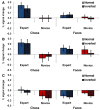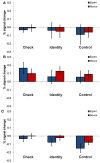The temporo-parietal junction contributes to global gestalt perception-evidence from studies in chess experts
- PMID: 24009574
- PMCID: PMC3755212
- DOI: 10.3389/fnhum.2013.00513
The temporo-parietal junction contributes to global gestalt perception-evidence from studies in chess experts
Abstract
In a recent neuroimaging study the comparison of intact vs. disturbed perception of global gestalt indicated a significant role of the temporo-parietal junction (TPJ) in the intact perception of global gestalt (Huberle and Karnath, 2012). This location corresponded well with the areas known to be damaged or impaired in patients with simultanagnosia after stroke or due to neurodegenerative diseases. It was concluded that the TPJ plays an important role in the integration of individual items to a holistic percept. Thus, increased BOLD signals should be found in this region whenever a task calls for the integration of multiple visual items. Behavioral experiments in chess experts suggested that their superior skills in comparison to chess novices are partly based on fast holistic processing of chess positions with multiple pieces. We thus analyzed BOLD data from four fMRI studies that compared chess experts with chess novices during the presentation of complex chess-related visual stimuli (Bilalić et al., 2010, 2011a,b, 2012). Three regions of interests were defined by significant TPJ clusters in the abovementioned study of global gestalt perception (Huberle and Karnath, 2012) and BOLD signal amplitudes in these regions were compared between chess experts and novices. These cross-paradigm ROI analyses revealed higher signals at the TPJ in chess experts in comparison to novices during presentations of complex chess positions. This difference was consistent across the different tasks in five independent experiments. Our results confirm the assumption that the TPJ region identified in previous work on global gestalt perception plays an important role in the processing of complex visual stimulus configurations.
Keywords: chess; expertise; fMRI; gestalt perception; object perception; simultanagnosia; temporo-parietal junction; visual grouping.
Figures






Similar articles
-
The role of temporo-parietal junction (TPJ) in global Gestalt perception.Brain Struct Funct. 2012 Jul;217(3):735-46. doi: 10.1007/s00429-011-0369-y. Epub 2011 Dec 23. Brain Struct Funct. 2012. PMID: 22193335
-
Bilateral theta-burst TMS to influence global gestalt perception.PLoS One. 2012;7(10):e47820. doi: 10.1371/journal.pone.0047820. Epub 2012 Oct 26. PLoS One. 2012. PMID: 23110106 Free PMC article.
-
Neuro-cognitive mechanisms of global Gestalt perception in visual quantification.Neuroimage. 2018 Nov 1;181:359-369. doi: 10.1016/j.neuroimage.2018.07.026. Epub 2018 Jul 18. Neuroimage. 2018. PMID: 30010007
-
The inferior parietal lobule and temporoparietal junction: A network perspective.Neuropsychologia. 2017 Oct;105:70-83. doi: 10.1016/j.neuropsychologia.2017.01.001. Epub 2017 Jan 3. Neuropsychologia. 2017. PMID: 28057458 Review.
-
Gestalt principles in the control of motor action.Psychol Bull. 2011 May;137(3):443-62. doi: 10.1037/a0022361. Psychol Bull. 2011. PMID: 21299272 Review.
Cited by
-
The enigma of Bálint's syndrome: neural substrates and cognitive deficits.Front Hum Neurosci. 2014 Mar 7;8:123. doi: 10.3389/fnhum.2014.00123. eCollection 2014. Front Hum Neurosci. 2014. PMID: 24639641 Free PMC article. No abstract available.
-
Does the Neurotypical Human Have a 'Theory of Mind'?J Autism Dev Disord. 2023 Feb;53(2):853-857. doi: 10.1007/s10803-021-05381-2. Epub 2021 Dec 1. J Autism Dev Disord. 2023. PMID: 34853957 No abstract available.
-
Spatial Arrangement and Set Size Influence the Coding of Non-symbolic Quantities in the Intraparietal Sulcus.Front Hum Neurosci. 2018 Feb 20;12:54. doi: 10.3389/fnhum.2018.00054. eCollection 2018. Front Hum Neurosci. 2018. PMID: 29515382 Free PMC article.
-
Classification of evoked responses to inverted faces reveals both spatial and temporal cortical response abnormalities in Autism spectrum disorder.Neuroimage Clin. 2021;29:102501. doi: 10.1016/j.nicl.2020.102501. Epub 2020 Nov 30. Neuroimage Clin. 2021. PMID: 33310630 Free PMC article.
-
Distinguishing Laparoscopic Surgery Experts from Novices Using EEG Topographic Features.Brain Sci. 2023 Dec 11;13(12):1706. doi: 10.3390/brainsci13121706. Brain Sci. 2023. PMID: 38137154 Free PMC article.
References
-
- Bálint R. (1909). Seelenlähmung des “Schauens,” optische Ataxie, räumliche Störung der Aufmerksamkeit. Monatsschr. Psychiatr. Neurol. 25, 51–81
-
- Bilalić M., McLeod P., Gobet F. (2008a). Expert and “novice” problem solving strategies in chess: sixty years of citing de Groot, (1946). Think. Reason. 14, 395–408 10.1080/13546780802265547 - DOI
LinkOut - more resources
Full Text Sources
Other Literature Sources

